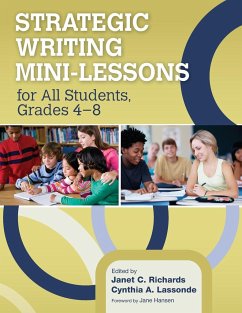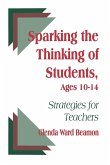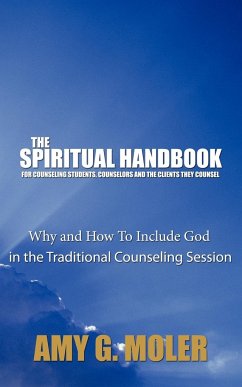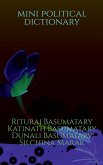- Broschiertes Buch
- Merkliste
- Auf die Merkliste
- Bewerten Bewerten
- Teilen
- Produkt teilen
- Produkterinnerung
- Produkterinnerung
Power up writing instruction with short, differentiated lessons! The hard reality? By the time they reach middle school, many of our students still lack basic writing skills, and this is their last opportunity to get up to speed before they reach high school. This toolbox of 23 mini-lessons will help you intervene and develop confident, competent writers. You'll find: Proven lessons that develop four essential writing strategies: inventing, drafting, revising, and editing Adaptations for struggling writers, English Language Learners, and advanced writers, with visual tools A schematic linking lessons to Common Core grade-level goals…mehr
Andere Kunden interessierten sich auch für
![Sparking the Thinking of Students, Ages 10-14 Sparking the Thinking of Students, Ages 10-14]() Glenda Ward BeamonSparking the Thinking of Students, Ages 10-1431,99 €
Glenda Ward BeamonSparking the Thinking of Students, Ages 10-1431,99 €![A Mini Review of Water-soluble Aminoplastic for Electron Microscopy A Mini Review of Water-soluble Aminoplastic for Electron Microscopy]() Johnson GaoA Mini Review of Water-soluble Aminoplastic for Electron Microscopy18,99 €
Johnson GaoA Mini Review of Water-soluble Aminoplastic for Electron Microscopy18,99 €![A Static Aeroelastic Analysis of a Flexible Wing Mini Unmanned Aerial Vehicle A Static Aeroelastic Analysis of a Flexible Wing Mini Unmanned Aerial Vehicle]() Nathan A. PitcherA Static Aeroelastic Analysis of a Flexible Wing Mini Unmanned Aerial Vehicle61,99 €
Nathan A. PitcherA Static Aeroelastic Analysis of a Flexible Wing Mini Unmanned Aerial Vehicle61,99 €![Journal of International Students, May-August 2018 ~ Volume 8 Number 2 Journal of International Students, May-August 2018 ~ Volume 8 Number 2]() Krishna BistaJournal of International Students, May-August 2018 ~ Volume 8 Number 255,99 €
Krishna BistaJournal of International Students, May-August 2018 ~ Volume 8 Number 255,99 €![The Help Book for Students, Parents, and Teachers The Help Book for Students, Parents, and Teachers]() Michael O ChapmanThe Help Book for Students, Parents, and Teachers21,99 €
Michael O ChapmanThe Help Book for Students, Parents, and Teachers21,99 €![The Spiritual Handbook for Counseling Students, Counselors and the Clients They Counsel The Spiritual Handbook for Counseling Students, Counselors and the Clients They Counsel]() Amy G. MolerThe Spiritual Handbook for Counseling Students, Counselors and the Clients They Counsel15,99 €
Amy G. MolerThe Spiritual Handbook for Counseling Students, Counselors and the Clients They Counsel15,99 €![Mini Political Dictionary Mini Political Dictionary]() Rituraj BasumataryMini Political Dictionary13,99 €
Rituraj BasumataryMini Political Dictionary13,99 €-
-
-
Power up writing instruction with short, differentiated lessons! The hard reality? By the time they reach middle school, many of our students still lack basic writing skills, and this is their last opportunity to get up to speed before they reach high school. This toolbox of 23 mini-lessons will help you intervene and develop confident, competent writers. You'll find: Proven lessons that develop four essential writing strategies: inventing, drafting, revising, and editing Adaptations for struggling writers, English Language Learners, and advanced writers, with visual tools A schematic linking lessons to Common Core grade-level goals
Hinweis: Dieser Artikel kann nur an eine deutsche Lieferadresse ausgeliefert werden.
Hinweis: Dieser Artikel kann nur an eine deutsche Lieferadresse ausgeliefert werden.
Produktdetails
- Produktdetails
- Verlag: Corwin
- Seitenzahl: 264
- Erscheinungstermin: 8. November 2012
- Englisch
- Abmessung: 280mm x 216mm x 14mm
- Gewicht: 673g
- ISBN-13: 9781452235011
- ISBN-10: 1452235015
- Artikelnr.: 35560935
- Herstellerkennzeichnung
- Libri GmbH
- Europaallee 1
- 36244 Bad Hersfeld
- gpsr@libri.de
- Verlag: Corwin
- Seitenzahl: 264
- Erscheinungstermin: 8. November 2012
- Englisch
- Abmessung: 280mm x 216mm x 14mm
- Gewicht: 673g
- ISBN-13: 9781452235011
- ISBN-10: 1452235015
- Artikelnr.: 35560935
- Herstellerkennzeichnung
- Libri GmbH
- Europaallee 1
- 36244 Bad Hersfeld
- gpsr@libri.de
Janet Richards, a former elementary teacher, is a Professor of Literacy in the Department of Childhood Education and Literacy Studies, College of Education at the University of South Florida where she teaches graduate courses in reading, writing, and qualitative methods. Her research interests include devising reading comprehension and writing strategies and investigating changes in education majors′ beliefs and cognitions as they participate in field programs. Richards is Senior Editor of the Journal of Reading Education and has published over 130 articles in scholarly journals. This is her ninth book. Cindy Lassonde moved to teaching at the college level after over 20 years as an elementary teacher. For the majority of her career, she taught elementary language arts and especially enjoyed teaching children how to improve their writing. Currently, she is Associate Professor at the State University of New York College at Oneonta teaching undergraduate and graduate literacy courses. As Editor of Excelsior: Leadership in Teaching and Learning, Lassonde enjoys working with researchers to polish their writing for publication. She has been published widely in professional journals and has written and edited a number of books on teaching, writing, and research.
Foreword by Jane Hansen
Introduction: Meeting Your Students' Needs With Specific Writing Strategies
by Janet C. Richards, Cynthia A. Lassonde
Section I. Strategic Inventing: Contemplating Ideas
1. Color-Coding Sources by Cynthia A. Lassonde
2. Developing Students' Awareness of Their Strengths as Writers with an
I-Can! Chart by Joanne Durham
3. Using a Blueprint Graphic Organizer to Build a Story by Jennifer A.
Fontenot
4. Using Genre Charts to Guide Planning and Writing by Gabe Horn, Susan D.
Martin
5. Reciprocal Text Structure Mapping for Expository Writing by Joyce C.
Fine
6. Thanks for the Memories! Using a Sensory-Details Chart to Prepare to
Write by Sandra Gandy, Mariah Kraus
7. Organizing an Expository Essay: Using Big Idea Checklists to Support
Writers by Allison Stone, Joyce C. Fine
Section II. Strategic Drafting: Putting Ideas on Paper
8. Quilting Together an Expository Paper in Four Steps by Cynthia A.
Lassonde
9. Team Writing to Foster Students' Motivation to Write: Moving From Group
Work to Independence by Janet C. Richards
10. Use Your Words: Learning to Paraphrase by Janet C. Richards
11. Creating Rounded Characters through Cartoon Connections by Krishna
Seunarinesingh
12. Applying the Structure Strategy to Write Persuasive Texts by Bonnie J.
F. Meyer, Jennifer Ireland, Melissa Ray
13. Buddies Build It Stronger: A Sentence-Combining Strategy by Todd
Sundeen
Section III. Strategic Revising: Attending to Organization and Cohesiveness
14. Deconstruct Then Reconstruct a First Draft by Cynthia A. Lassonde
15. Portal Writing: A Strategy to Help Writers Rethink Their Writing by S.
Rebecca Leigh
16. Conferring with an Avatar by Chase Young, Lynda Swanner
17. Writing Aloud: A Sound-Savvy Approach to Writing by Sandra K. Athans
18. A Picture Is Worth a Thousand Words: Revising With Photographs by
Noreen S. Moore
Section IV. Strategic Editing: The Finishing Touch
19. Revising and Editing Through Primary Sources by Nancy Williams,
Kathleen Muir
20. Code Switching, an Editing Strategy by Rebecca Wheeler
21. The Imagine, Describe, Resolve, and Confrim (IDRC) Strategy by Lindsay
Sheronick Yearta, Katie Stover, Lynne Newton, Karen Wood
22. Probable Passages: Using Story Structure to Write and Revise a
Predictive Passage by Katie Stover, Jean Vintinner, Crystal Glover, Karen
Wood
References
Index
About the Authors
About the Contributors
Introduction: Meeting Your Students' Needs With Specific Writing Strategies
by Janet C. Richards, Cynthia A. Lassonde
Section I. Strategic Inventing: Contemplating Ideas
1. Color-Coding Sources by Cynthia A. Lassonde
2. Developing Students' Awareness of Their Strengths as Writers with an
I-Can! Chart by Joanne Durham
3. Using a Blueprint Graphic Organizer to Build a Story by Jennifer A.
Fontenot
4. Using Genre Charts to Guide Planning and Writing by Gabe Horn, Susan D.
Martin
5. Reciprocal Text Structure Mapping for Expository Writing by Joyce C.
Fine
6. Thanks for the Memories! Using a Sensory-Details Chart to Prepare to
Write by Sandra Gandy, Mariah Kraus
7. Organizing an Expository Essay: Using Big Idea Checklists to Support
Writers by Allison Stone, Joyce C. Fine
Section II. Strategic Drafting: Putting Ideas on Paper
8. Quilting Together an Expository Paper in Four Steps by Cynthia A.
Lassonde
9. Team Writing to Foster Students' Motivation to Write: Moving From Group
Work to Independence by Janet C. Richards
10. Use Your Words: Learning to Paraphrase by Janet C. Richards
11. Creating Rounded Characters through Cartoon Connections by Krishna
Seunarinesingh
12. Applying the Structure Strategy to Write Persuasive Texts by Bonnie J.
F. Meyer, Jennifer Ireland, Melissa Ray
13. Buddies Build It Stronger: A Sentence-Combining Strategy by Todd
Sundeen
Section III. Strategic Revising: Attending to Organization and Cohesiveness
14. Deconstruct Then Reconstruct a First Draft by Cynthia A. Lassonde
15. Portal Writing: A Strategy to Help Writers Rethink Their Writing by S.
Rebecca Leigh
16. Conferring with an Avatar by Chase Young, Lynda Swanner
17. Writing Aloud: A Sound-Savvy Approach to Writing by Sandra K. Athans
18. A Picture Is Worth a Thousand Words: Revising With Photographs by
Noreen S. Moore
Section IV. Strategic Editing: The Finishing Touch
19. Revising and Editing Through Primary Sources by Nancy Williams,
Kathleen Muir
20. Code Switching, an Editing Strategy by Rebecca Wheeler
21. The Imagine, Describe, Resolve, and Confrim (IDRC) Strategy by Lindsay
Sheronick Yearta, Katie Stover, Lynne Newton, Karen Wood
22. Probable Passages: Using Story Structure to Write and Revise a
Predictive Passage by Katie Stover, Jean Vintinner, Crystal Glover, Karen
Wood
References
Index
About the Authors
About the Contributors
Foreword by Jane Hansen
Introduction: Meeting Your Students' Needs With Specific Writing Strategies
by Janet C. Richards, Cynthia A. Lassonde
Section I. Strategic Inventing: Contemplating Ideas
1. Color-Coding Sources by Cynthia A. Lassonde
2. Developing Students' Awareness of Their Strengths as Writers with an
I-Can! Chart by Joanne Durham
3. Using a Blueprint Graphic Organizer to Build a Story by Jennifer A.
Fontenot
4. Using Genre Charts to Guide Planning and Writing by Gabe Horn, Susan D.
Martin
5. Reciprocal Text Structure Mapping for Expository Writing by Joyce C.
Fine
6. Thanks for the Memories! Using a Sensory-Details Chart to Prepare to
Write by Sandra Gandy, Mariah Kraus
7. Organizing an Expository Essay: Using Big Idea Checklists to Support
Writers by Allison Stone, Joyce C. Fine
Section II. Strategic Drafting: Putting Ideas on Paper
8. Quilting Together an Expository Paper in Four Steps by Cynthia A.
Lassonde
9. Team Writing to Foster Students' Motivation to Write: Moving From Group
Work to Independence by Janet C. Richards
10. Use Your Words: Learning to Paraphrase by Janet C. Richards
11. Creating Rounded Characters through Cartoon Connections by Krishna
Seunarinesingh
12. Applying the Structure Strategy to Write Persuasive Texts by Bonnie J.
F. Meyer, Jennifer Ireland, Melissa Ray
13. Buddies Build It Stronger: A Sentence-Combining Strategy by Todd
Sundeen
Section III. Strategic Revising: Attending to Organization and Cohesiveness
14. Deconstruct Then Reconstruct a First Draft by Cynthia A. Lassonde
15. Portal Writing: A Strategy to Help Writers Rethink Their Writing by S.
Rebecca Leigh
16. Conferring with an Avatar by Chase Young, Lynda Swanner
17. Writing Aloud: A Sound-Savvy Approach to Writing by Sandra K. Athans
18. A Picture Is Worth a Thousand Words: Revising With Photographs by
Noreen S. Moore
Section IV. Strategic Editing: The Finishing Touch
19. Revising and Editing Through Primary Sources by Nancy Williams,
Kathleen Muir
20. Code Switching, an Editing Strategy by Rebecca Wheeler
21. The Imagine, Describe, Resolve, and Confrim (IDRC) Strategy by Lindsay
Sheronick Yearta, Katie Stover, Lynne Newton, Karen Wood
22. Probable Passages: Using Story Structure to Write and Revise a
Predictive Passage by Katie Stover, Jean Vintinner, Crystal Glover, Karen
Wood
References
Index
About the Authors
About the Contributors
Introduction: Meeting Your Students' Needs With Specific Writing Strategies
by Janet C. Richards, Cynthia A. Lassonde
Section I. Strategic Inventing: Contemplating Ideas
1. Color-Coding Sources by Cynthia A. Lassonde
2. Developing Students' Awareness of Their Strengths as Writers with an
I-Can! Chart by Joanne Durham
3. Using a Blueprint Graphic Organizer to Build a Story by Jennifer A.
Fontenot
4. Using Genre Charts to Guide Planning and Writing by Gabe Horn, Susan D.
Martin
5. Reciprocal Text Structure Mapping for Expository Writing by Joyce C.
Fine
6. Thanks for the Memories! Using a Sensory-Details Chart to Prepare to
Write by Sandra Gandy, Mariah Kraus
7. Organizing an Expository Essay: Using Big Idea Checklists to Support
Writers by Allison Stone, Joyce C. Fine
Section II. Strategic Drafting: Putting Ideas on Paper
8. Quilting Together an Expository Paper in Four Steps by Cynthia A.
Lassonde
9. Team Writing to Foster Students' Motivation to Write: Moving From Group
Work to Independence by Janet C. Richards
10. Use Your Words: Learning to Paraphrase by Janet C. Richards
11. Creating Rounded Characters through Cartoon Connections by Krishna
Seunarinesingh
12. Applying the Structure Strategy to Write Persuasive Texts by Bonnie J.
F. Meyer, Jennifer Ireland, Melissa Ray
13. Buddies Build It Stronger: A Sentence-Combining Strategy by Todd
Sundeen
Section III. Strategic Revising: Attending to Organization and Cohesiveness
14. Deconstruct Then Reconstruct a First Draft by Cynthia A. Lassonde
15. Portal Writing: A Strategy to Help Writers Rethink Their Writing by S.
Rebecca Leigh
16. Conferring with an Avatar by Chase Young, Lynda Swanner
17. Writing Aloud: A Sound-Savvy Approach to Writing by Sandra K. Athans
18. A Picture Is Worth a Thousand Words: Revising With Photographs by
Noreen S. Moore
Section IV. Strategic Editing: The Finishing Touch
19. Revising and Editing Through Primary Sources by Nancy Williams,
Kathleen Muir
20. Code Switching, an Editing Strategy by Rebecca Wheeler
21. The Imagine, Describe, Resolve, and Confrim (IDRC) Strategy by Lindsay
Sheronick Yearta, Katie Stover, Lynne Newton, Karen Wood
22. Probable Passages: Using Story Structure to Write and Revise a
Predictive Passage by Katie Stover, Jean Vintinner, Crystal Glover, Karen
Wood
References
Index
About the Authors
About the Contributors








